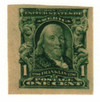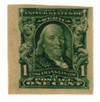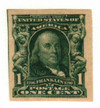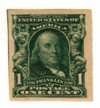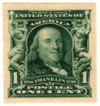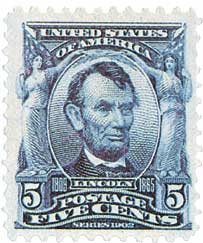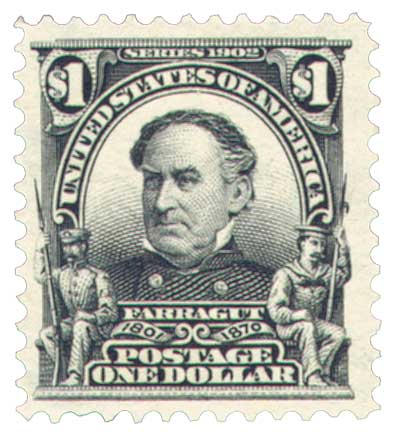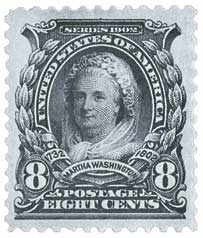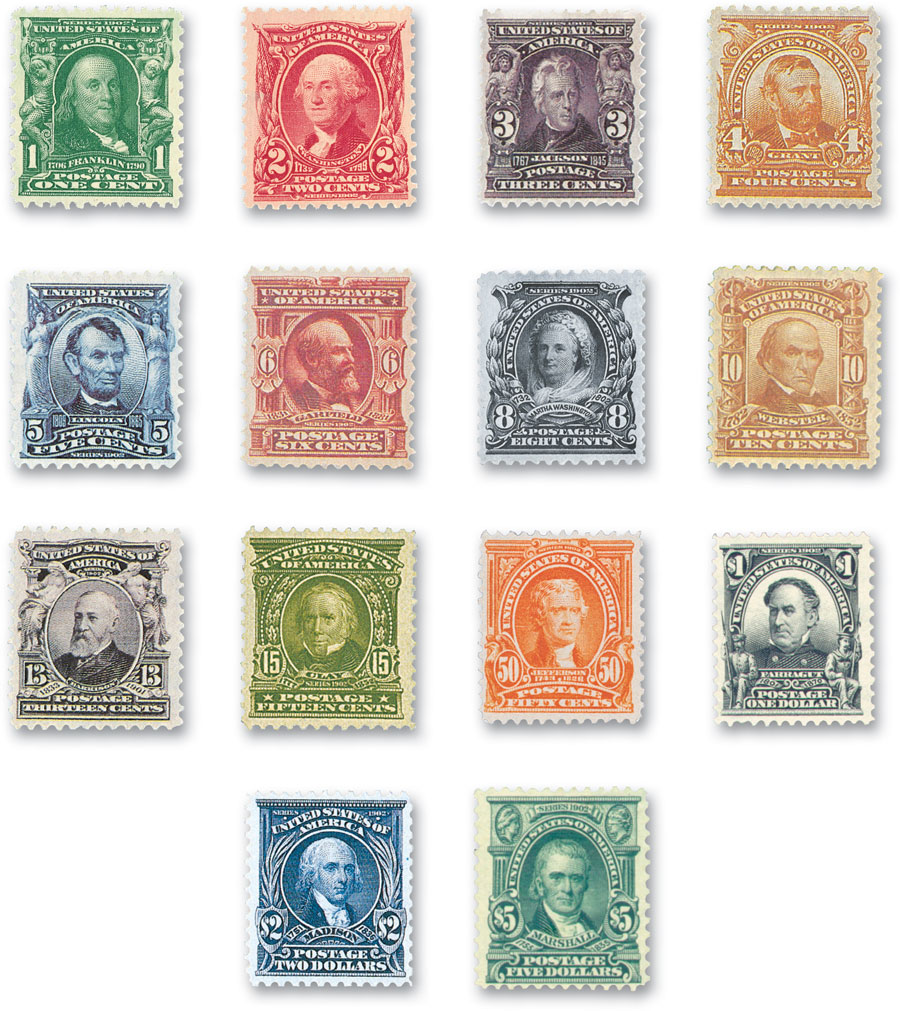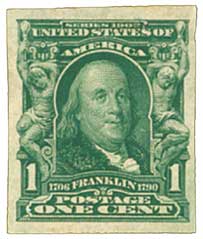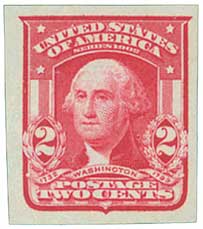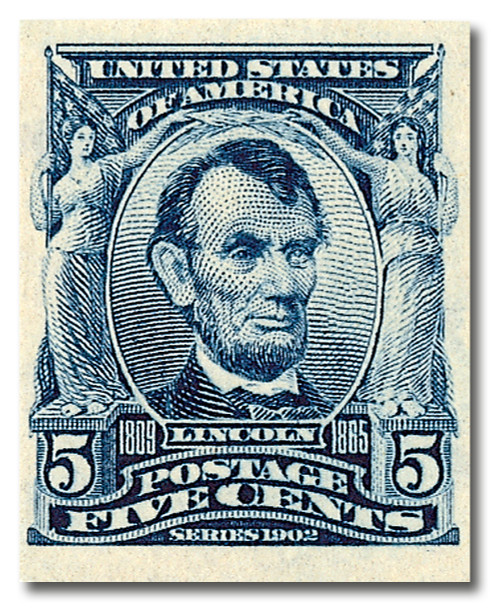
# 314 - 1906 1c Franklin, imperforate
1906-08 1¢ Franklin
Quantity issued: 5,015,000
Printed by: Bureau of Engraving and Printing
Method: Flat plate
Watermark: Double line
Perforation: Imperforate
Color: Blue green
Imperforate U.S. #314 was used primarily in vending machines. The stamps were printed in full sheets of 400 subjects, which were divided into panes of 100 by horizontal and vertical guide lines. These lines appeared on the private coils every 20 stamps.
When the 1¢ Franklin and 2¢ Washington were first issued imperforate, a scheming young man took advantage of the situation. At the time the stamps were first released, they were available only in Chicago. Seizing the opportunity to “make a quick buck,” he told New York dealers that, according to a friend who worked for the Postal Department, these sheets were an error and only a few had gotten out. Eager to own a rare and valuable error, the dealers snatched up the sheets for $10 to $25 apiece!
When the sheets came out in New York a few days later, they knew they’d “been had.” The sheets, containing 100 stamps, sold for a mere $2. One dealer sold his copies for $2.00 a block, with the statement, “it might be a scarce item or perhaps become a regular issue.”
In 1908, an imperforate 5¢ Lincoln was issued. Both stamps were issued imperforate to be used in the newly developed vending machines, which required special perforations. Private manufacturers of the machines would purchase the imperforate stamps and then apply their own perforations.
Start of the Series of 1902-03
On November 18, 1902, the US Post Office issued the first stamp in the Series of 1902-03.
In 1902, the Bureau of Engraving and Printing’s workmanship on the 1901 Pan-American series impressed the Post Office Department. So they decided to inaugurate a new general issue to replace the then-current Regular Issues, which had been in use with only minor changes for more than ten years. They hoped these new stamps would create the same excitement for regular issues that the Pan-Americans had received.
The Series of 1902-03, known as the Second Bureau Issue, was the first series completely designed by the Bureau of Engraving and Printing. The previous issues used designs from the American Bank Note Company.
The first stamp, US #308, was issued on November 18, 1902. It was the first US stamp with a 13¢ denomination, and the first to honor President Benjamin Harrison. Used on international mail, it prepaid the rate for a 1/2-ounce letter to any country in the Postal Union, 10¢ for the registered fee and 3¢ for postage.
Officials expected heavy demand for the 13¢ stamp, anticipating its use in place of an 8¢ stamp for the Registry fee and a 5¢ stamp for postage on letters to foreign destinations. However, the public rejected the stamps and sales were the lowest of any of the denominations under 50¢.
The designs of the stamps in this new series were markedly different from previous issues. They had far more ornate designs – each stamp’s border was different and highly detailed. Several borders even pictured people! The ornate new designs, however, were not the only addition to the 1902 series. Each stamp also included the name of the person pictured and their dates of birth and death – a first for US postage.
The Series of 1902 included two other new faces in addition to Harrison – Admiral David Farragut and Martha Washington. Martha Washington’s stamp was the first US stamp to honor an American woman.
A slight change was also made in the format. Each stamp in this series bears the inscription, “Series 1902.” This caused some concern abroad, as many European philatelists wondered whether the US was planning on issuing new stamps each year. Many of the stamps, however, did not even reach post offices until 1903, and the next general issues were not produced until 1908.
At the time, some of the stamps received negative criticism. In particular, some criticized the 1¢ Franklin. Art critics and stamp experts claimed the portrait looked like a caricature, while the overall design was unbecoming. However, today we see this series as an excellent representation of early 20th-century US stamps at their best. And some consider the Series of 1902 to be the most beautiful ever issued by the US.
The Imperforate Stamps of 1906-08
In 1906, the 1¢ and 2¢ stamps were produced imperforate for use in vending machines. The stamps were first issued in Chicago, leaving New York dealers unaware of its existence for a short time. This led to one of the most interesting stamp stories of the era.
A scheming young man in Chicago took advantage of the situation to “make a quick buck.” He told New York dealers that, according to a friend who worked for the Postal Department, these imperforate sheets were an error and only a few had gotten out. Eager to own a rare and valuable error, the dealers snatched up the sheets for $10 to $25 apiece!
When the sheets came out in New York a few days later, they knew they’d “been had.” The sheets, containing 100 stamps, sold for a mere $2. One dealer sold his copies for $2.00 a block, with the statement, “it might be a scarce item or perhaps become a regular issue.”
Click here to see all the Series of 1902-03 stamps.
1906-08 1¢ Franklin
Quantity issued: 5,015,000
Printed by: Bureau of Engraving and Printing
Method: Flat plate
Watermark: Double line
Perforation: Imperforate
Color: Blue green
Imperforate U.S. #314 was used primarily in vending machines. The stamps were printed in full sheets of 400 subjects, which were divided into panes of 100 by horizontal and vertical guide lines. These lines appeared on the private coils every 20 stamps.
When the 1¢ Franklin and 2¢ Washington were first issued imperforate, a scheming young man took advantage of the situation. At the time the stamps were first released, they were available only in Chicago. Seizing the opportunity to “make a quick buck,” he told New York dealers that, according to a friend who worked for the Postal Department, these sheets were an error and only a few had gotten out. Eager to own a rare and valuable error, the dealers snatched up the sheets for $10 to $25 apiece!
When the sheets came out in New York a few days later, they knew they’d “been had.” The sheets, containing 100 stamps, sold for a mere $2. One dealer sold his copies for $2.00 a block, with the statement, “it might be a scarce item or perhaps become a regular issue.”
In 1908, an imperforate 5¢ Lincoln was issued. Both stamps were issued imperforate to be used in the newly developed vending machines, which required special perforations. Private manufacturers of the machines would purchase the imperforate stamps and then apply their own perforations.
Start of the Series of 1902-03
On November 18, 1902, the US Post Office issued the first stamp in the Series of 1902-03.
In 1902, the Bureau of Engraving and Printing’s workmanship on the 1901 Pan-American series impressed the Post Office Department. So they decided to inaugurate a new general issue to replace the then-current Regular Issues, which had been in use with only minor changes for more than ten years. They hoped these new stamps would create the same excitement for regular issues that the Pan-Americans had received.
The Series of 1902-03, known as the Second Bureau Issue, was the first series completely designed by the Bureau of Engraving and Printing. The previous issues used designs from the American Bank Note Company.
The first stamp, US #308, was issued on November 18, 1902. It was the first US stamp with a 13¢ denomination, and the first to honor President Benjamin Harrison. Used on international mail, it prepaid the rate for a 1/2-ounce letter to any country in the Postal Union, 10¢ for the registered fee and 3¢ for postage.
Officials expected heavy demand for the 13¢ stamp, anticipating its use in place of an 8¢ stamp for the Registry fee and a 5¢ stamp for postage on letters to foreign destinations. However, the public rejected the stamps and sales were the lowest of any of the denominations under 50¢.
The designs of the stamps in this new series were markedly different from previous issues. They had far more ornate designs – each stamp’s border was different and highly detailed. Several borders even pictured people! The ornate new designs, however, were not the only addition to the 1902 series. Each stamp also included the name of the person pictured and their dates of birth and death – a first for US postage.
The Series of 1902 included two other new faces in addition to Harrison – Admiral David Farragut and Martha Washington. Martha Washington’s stamp was the first US stamp to honor an American woman.
A slight change was also made in the format. Each stamp in this series bears the inscription, “Series 1902.” This caused some concern abroad, as many European philatelists wondered whether the US was planning on issuing new stamps each year. Many of the stamps, however, did not even reach post offices until 1903, and the next general issues were not produced until 1908.
At the time, some of the stamps received negative criticism. In particular, some criticized the 1¢ Franklin. Art critics and stamp experts claimed the portrait looked like a caricature, while the overall design was unbecoming. However, today we see this series as an excellent representation of early 20th-century US stamps at their best. And some consider the Series of 1902 to be the most beautiful ever issued by the US.
The Imperforate Stamps of 1906-08
In 1906, the 1¢ and 2¢ stamps were produced imperforate for use in vending machines. The stamps were first issued in Chicago, leaving New York dealers unaware of its existence for a short time. This led to one of the most interesting stamp stories of the era.
A scheming young man in Chicago took advantage of the situation to “make a quick buck.” He told New York dealers that, according to a friend who worked for the Postal Department, these imperforate sheets were an error and only a few had gotten out. Eager to own a rare and valuable error, the dealers snatched up the sheets for $10 to $25 apiece!
When the sheets came out in New York a few days later, they knew they’d “been had.” The sheets, containing 100 stamps, sold for a mere $2. One dealer sold his copies for $2.00 a block, with the statement, “it might be a scarce item or perhaps become a regular issue.”
Click here to see all the Series of 1902-03 stamps.





